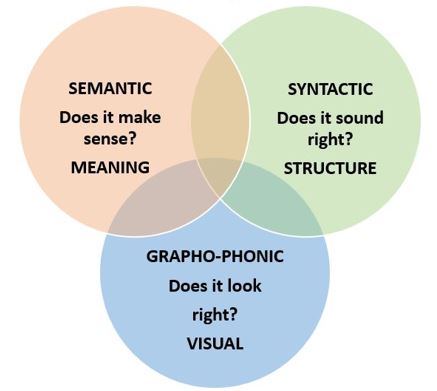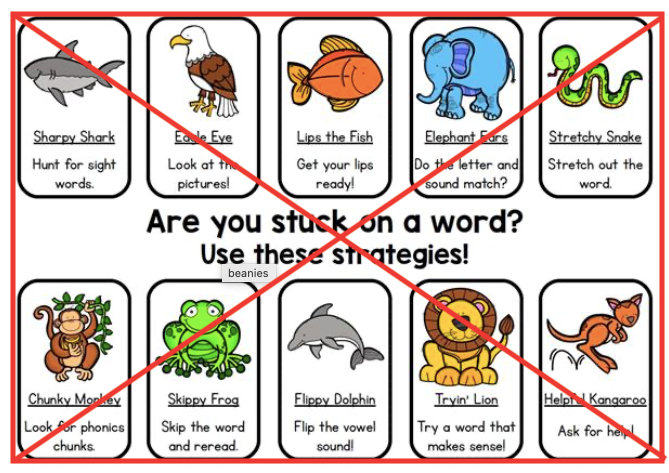The three-cueing approach is common in early reading instruction but it is not in keeping with evidence on how children learn to read
The three-cueing system for reading is based on the psycholinguistic theories of Ken Goodman & Frank Smith, first published in the 1960s. The three-cueing model says that skilled reading involves gaining meaning from print using three types of cues:
- Semantic (word meaning and sentence context)
- Syntactic (grammatical features)
- Graphophonic (letters and sounds)
This model is a constructivist theory of reading foundational to whole language and Balanced Literacy approaches. It is used widely in school reading programs including Fountas & Pinnell Literacy, Reading Recovery, Leveled Literacy Intervention, and L3.
In the three-cueing appproach, children are encouraged to use semantic and grammatical cues first when they are attempting to read an unknown word (e.g., “What word would make sense here?”). Using graphophonic cues, such as noticing the letters in a word, or sounding out the unknown word using phonic knowledge, are used last. In this model, phonic knowledge should be used for confirming predictions in reading, not as the first strategy (Emmitt et al., 2013).
Knowledge of phonics is downplayed in a three-cueing model because Smith (1973) mistakenly believed that an experienced and fluent reader identifies words (if they identify the word at all) as an ideogram, meaning that we read words as unanalysed wholes. This means that systematic and explicit approaches to phonics instruction are incompatible with the three cueing model. For a full discussion on this visit our sight word page.
Unfortunately, many children, such as those with poor phonemic awareness skills, poor vocabularies, or those students with a learning difficulty or who are English as a second language (ESL) learners, will be severely disadvantaged by strategies that encourage guessing. Many of these students never move away from trying to make meaning through semantic and linguistic cues.
Why the three-cueing system is ineffective for learning to read
The central belief in the three-cueing model is the belief that readers do not need to read every letter in a word, or every word in a sentence; they instead ‘sample’ from the text and they rely on prediction and semantic context to extract meaning. Scientific studies of reading have demonstrated that skilled readers do indeed process every letter of the printed word (see Castles, Rastle & Nation, 2018) . This is done so quickly and automatically that it’s imperceptible to the reader. Initial encounters with words are slow until each word becomes unitised (stored in memory as a unique letter string) and fast word recognition develops.
Multiple research studies have also provided evidence that skilled readers recognise a word’s spelling and pronunciation before its meaning (Stanovich, Nathan, West, & Vala-Rossi, 1985; Forster, 2012; Maurer & McCandiss, 2008; Perfetti, 2011). Therefore learning to read via mapping of grapheme-phoneme correspondences is more efficient than learning to read words by context. We get to meaning via our understanding of phonemes, hence phonemic awareness and phonic skills are essential foundational skills for reading.
The research evidence suggests that the three-cueing approach to reading is counterproductive for weaker students because it reinforces the habits of poor readers and does not give them the systematic and explicit teaching necessary for them to be able to make the connection between the spoken and the printed word (Tunmer et al., 2002).
David Kilpatrick (2015) summarises the problems with the three-cueing model:
- Skilled word reading does not require context.
- Guessing words from context is not as efficient as phonic decoding.
- Poor readers, not skilled readers, rely heavily on context.
- Context guessing does not promote sight word learning in poor readers.
- Semantic errors are not a sign of better reading development than phonetic errors.
- One of the three cues in the three-cueing model is not related to word reading: syntax may be essential for comprehension, but it is not critical for word-reading development.
Are you using the three-cueing system?
You will know if you are using a three-cueing approach to reading if you have posters or prompts in your classroom that encourage the following. Do you instruct your students to:
- skip the word and come back to it
- look at the picture to work out the word , or
- try a word that makes sense.
If you do these things, you are using a three-cueing model of teaching reading.
Skippy Frog and friends are based on the three-cueing approach that encourages children to use strategies other than decoding to read unfamiliar words, which impedes their progress.
Teaching beginning readers the code of the English language has been proven in numerous research studies to yield superior outcomes on both word-level reading and comprehension compared to approaches with their roots in whole language or ‘balanced’ pedagogies (National Reading Panel, 2000; Torgerson, Brooks & Hall 2006 ). This is not to say that teaching phonics to beginning readers will solve all reading difficulties, but will provide them with the tools they need to make an excellent start.


